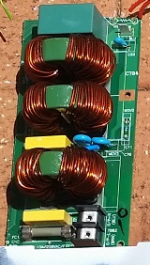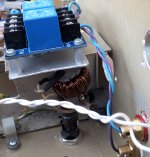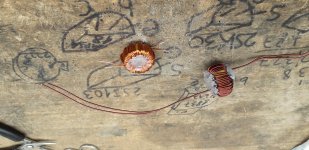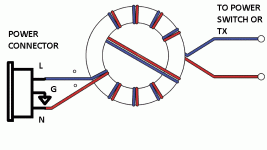I propose a trick that I learnt in my early days as DIYer, extracted from a pro site dedicated to digital transport upgrades, and which I used to use only in "dirty" SMPS for digital sources but which, with time, proved useful also for linear supplies and for analog sources (mi Otari R2R) and also with my Amnesis amplifier. It is the Joe Reisert type of Balun, with bifilar winding. The optimal is built using high Q ring core, with a material that can reach tens of KHz, using OCC enameled copper wire, BUT, it also works with ferrites rescued from SMPS' and common type enameled copper.
I am sure the experts will opine on the merits or the demerits of the idea and maybe some will try it and even measure it.
I've been asked how many turns for the "Reisert Bifilar Balun"?
Based on recent listening, I believe the more the better. I will probably re-wind some and see/listen.
I appears that R and C vary with N (n° of turns) but L vary with N squared, which apparently brings the resonant point lower...I hope this is a good thing
Anyway, there you have probably the best and cheapest upgrade of them ALL.
Best wishes,
M.
I am sure the experts will opine on the merits or the demerits of the idea and maybe some will try it and even measure it.
I've been asked how many turns for the "Reisert Bifilar Balun"?
Based on recent listening, I believe the more the better. I will probably re-wind some and see/listen.
I appears that R and C vary with N (n° of turns) but L vary with N squared, which apparently brings the resonant point lower...I hope this is a good thing
Anyway, there you have probably the best and cheapest upgrade of them ALL.
Best wishes,
M.
Attachments
Last edited:
Why ?.We call this a common mode choke. A bifilar winding with single insulated enamelled wire connected to mains supply is a call for a burning house. You should better keep your hands off mains circuits.

Such choke toroids are non conductive and have insulating encapsulation and are standard equpment in many applications.
If there is fuse upstream of the toroid what can be the risk/problem ?.
Dan.
Yes, if you want to make a CM choke for mains use then you need thicker insulation.
A bifilar-wound mains choke has full mains voltage across two thicknesses of enamel, unless something gets damaged when winding (or in use) in which case it is one layer of enamel. Further damage means no insulation.
A traditional toroidal choke may have a number of layers and hence the voltage appears across several thicknesses of insulation. In addition, it will normally not be mains voltage but merely the voltage drop across the winding. Don't compare apples with oranges and lead people to do unsafe things.
A bifilar-wound mains choke has full mains voltage across two thicknesses of enamel, unless something gets damaged when winding (or in use) in which case it is one layer of enamel. Further damage means no insulation.
A traditional toroidal choke may have a number of layers and hence the voltage appears across several thicknesses of insulation. In addition, it will normally not be mains voltage but merely the voltage drop across the winding. Don't compare apples with oranges and lead people to do unsafe things.
Last edited:
Yes, if you want to make a CM choke for mains use then you need thicker insulation.
A bifilar-wound mains choke has full mains voltage across two thicknesses of enamel, unless something gets damaged when winding (or in use) in which case it is one layer of enamel. Further damage means no insulation.
A traditional toroidal choke may have a number of layers and hence the voltage appears across several thicknesses of insulation. In addition, it will normally not be mains voltage but merely the voltage drop across the winding. Don't compare apples with oranges and lead people to do unsafe things.
I don't understand your concern! Tell me how are mains transformers wound?
DF96 as usual you are toxic FOS, commercial CM chokes like I illustrated use standard enameled wire.Yes, if you want to make a CM choke for mains use then you need thicker insulation.
Duh, that's why a fuse is included in the circuit upsteam of such CM choke....again check out the photo I included in my last post.A bifilar-wound mains choke has full mains voltage across two thicknesses of enamel, unless something gets damaged when winding (or in use) in which case it is one layer of enamel. Further damage means no insulation.
A standard inline fuse is the standard solution FFS.A traditional toroidal choke may have a number of layers and hence the voltage appears across several thicknesses of insulation. In addition, it will normally not be mains voltage but merely the voltage drop across the winding. Don't compare apples with oranges and lead people to do unsafe things.
Dan.
Last edited:
Many layers and extra insulation between some layers. As a result there is plenty of separation so all is safe.buziko said:Tell me how are mains transformers wound?
I always turn "toxic" where safety is concerned. That choke you show appears to have two winding sections. I cannot see whether it is bifilar wound or not. If it is, it may have unusually thick insulation if it comes from a reputable maker, or it may be Chinese junk - I cannot tell. The fact that someone has managed to engineer a safe CM choke using the correct enamelled wire does not mean that any enamelled wire can be used.Max Headroom said:DF96 as usual you are toxic FOS, commercial CM chokes like I illustrated use standard enameled wire.
Fuses are meant to guard against accidents, not incompetence. At least, that is the practice in Europe.Duh, that's why a fuse is included in the circuit upsteam of such CM choke
Beyond the OBVIOUS safety concerns...are there any measurements or data to peruse? Or is this just another "I tried this thing I saw on the interwebs and now my whole life is better" kind of thing? We can easily fool ourseves into believing things we sometimes shouldn't.
Mike
Mike
Nah, you are just naturally toxic and enjoy to be toxic as evidenced by the tone of your replies and commented on by other members behind the scenes....you might like to take this on board as constructive feedback.I always turn "toxic" where safety is concerned. That choke you show appears to have two winding sections. I cannot see whether it is bifilar wound or not. If it is, it may have unusually thick insulation if it comes from a reputable maker, or it may be Chinese junk - I cannot tell. The fact that someone has managed to engineer a safe CM choke using the correct enamelled wire does not mean that any enamelled wire can be used.
More of your negative/toxic BS, fuses are guards against failures, be it device or wiring failures, even UL approved stuff fails and pops fuses, go figure.Fuses are meant to guard against accidents, not incompetence. At least, that is the practice in Europe.
Dan.
Nah, you are just naturally toxic and enjoy to be toxic as evidenced by the tone of your replies and commented on by other members behind the scenes....you might like to take this on board as constructive feedback.
More of your negative/toxic BS, fuses are guards against failures, be it device or wiring failures, even UL approved stuff fails and pops fuses, go figure.
Dan.
You've never been electrocuted, have you?
Mike
I have serviced audio/video/tv electronics for 35 years.You've never been electrocuted, have you?
Please tell me all about short term electrocution and long term electrocution and at differing voltages and differing currents and differing durations.
Go right ahead, tell me what you found out ?.
Dan.
Referring to your first posting- I think you missed the point that the DIY-chokes were wound in a bifilar way, but the ones you presented were of the sectional winding type - which is in fact the common and safe technique for mains common mode chokes. That makes the difference we are talking aboutI have serviced audio/video/tv electronics for 35 years.
Please tell me all about short term electrocution and long term electrocution and at differing voltages and differing currents and differing durations.
Go right ahead, tell me what you found out ?.
Dan.
Last edited:
The point is that it really does not matter the winding/insulation method if an appropriate series fuse is incorporated in the primary circuit.Referring to your first posting- I think you missed the point that the DIY-chokes were wound in a bifilar way, but the ones you presented were of the sectional winding type - which is in fact the common and safe technique for mains common mode chokes. That makes the difference we are talking about
Voltage rating of standard enameled wire is around 600V, one has to be really careless in winding operation to cause two adjacent insulation faults that could cause primary SC fault.
Dan.
No, it does matter. Btw, standard enameled wire withstands 500Vdc. But mains filters have to withstand 230Vac plus much bigger transients as well. Whether you like this or not. And for that reason you will find no commercially cm-chokes with bifilar wound standard magnetic wire.The point is that it really does not matter the winding/insulation method if an appropriate series fuse is incorporated in the primary circuit.
Voltage rating of standard enameled wire is around 600V, one has to be really careless in winding operation to cause two adjacent insulation faults that could cause primary SC fault.
Dan.
I have serviced audio/video/tv electronics for 35 years.
Please tell me all about short term electrocution and long term electrocution and at differing voltages and differing currents and differing durations.
Go right ahead, tell me what you found out ?.
Dan.
I WAS electrocuted on the job in 1981, spent 2 days in the hospital...so YOUR expert opinion doesn't cut squat with me...DO NOT TAKE ELECTRICAL SAFETY FOR GRANTED...EVER!!
By the way, I serviced electronics and electrical for 25 years, thankfully retired now.
Mike
At the risk of adding a "toxic" opinion to this thread, I have to clarify this statement: ferrites used for suppression purpose in CM filters normally have a high permeability, and a high DC/AC conductivity: for example the T38 material in the Epcos classification or 3E3 for the Philips/Ferroxcube system.Why ?.
View attachment 793473
Such choke toroids are non conductive and have insulating encapsulation and are standard equpment in many applications.
If there is fuse upstream of the toroid what can be the risk/problem ?.
Dan.
These are MnZn ferrites, and for a voltage like 230VAC (or even 115VAC), they look like a short, because of their VDR properties they owe to their metal-oxide nature.
The toroid used in CM filters is normally covered with several thick insulating layers of lacquer to prevent any breakdown, but even so, I have seen a few examples where the insulation failed, causing a meltdown of the ferrite core (and a blown fuse, fortunately).
Some US and Japanese-made ferrites do not exactly fall into the MnZn category, and have properties in-between NiZn and MnZn materials, but at high enough voltages, they still behave as VDR's, even if their DC resistance looks infinite.
This means that all ferrite cores should be treated as conductive, except for extremely low voltages.
The enamel of the wire can just provide functional insulation, not safety insulation.
Several additional barriers are required for safety insulation
DF96 as usual you are toxic FOS, commercial CM chokes like I illustrated use standard enameled wire.
No such animal. All magnet wire has insulation, and there are many different kinds of insulation and voltage ratings for such insulation. Finer wires typically have to have thinner insulation and thus a lower rating, but only the datasheet for the actual product will tell you chapter and verse. There are classes for temperature limits for insulation too.
You certainly can't expect some random ECW to be rated for mains transients, bifilar or otherwise.
"Around 600V" isn't a rating! Its certainly not enough for mains equipment where multi-kV transients due to equipment or lightning are expected.
Let me tell you a story:
I bought a nice little TFT monitor (8 inch) for a project. It came with a mains SMPS wall-wart. I was seeing all sort of odd noise bursts (the project involved spectrum analysis and the noise floor was boogieing away like noone's business sporadically.
Eventually I put a scope on the power rail from this dodgy wall wart - torrents of spikey noise at sporadic intervals.
I bought a proper wall wart and broke this unit apart - the isolation transformer had primary and secondary windings crossing and touching. My noise was the insulation leaking in bursts - close to breakdown I suspect. So no, "standard ECW" is not enough.
Last edited:

Once again a thread has to be closed due to the dangers inherent in DIY components on the primary AC line.
We recognize that when building your own AC powered projects you have to connect to the AC line, but the least you can do is use proper safety recognized and approved components. There are very good reasons why there are safety organizations that certify what we connect to the power grid no matter what country you live in.

- Status
- Not open for further replies.
- Home
- Amplifiers
- Power Supplies
- The "Reisert Bifilar Balun" for Power Supplies.



 Mains wiring safety must be considered a top priority to prevent events such as shock or
Mains wiring safety must be considered a top priority to prevent events such as shock or 
 .
.